| 3Back | 5Start Page |
Last Update: may 8, 2005
Christiaan Huygens in RM2047
The Testelin portrait
I presented some arguments for identifying Christiaan Huygens among the scientists in the Etablissement de l'Académie des Sciences et fondation de l'observatoire by Henri Testelin (Verduin, 2004). Why, one might ask, look for Huygens in this particular painting at all?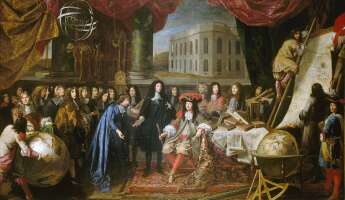 |
 |
The first argument for his presence is one of necessity. Huygens was what we would now call the scientific director of the Academy. The astronomer Ismael Boulliau called him "omnium caput" [5] and Robert Moray "Director of the designe" [6]. Therefore, as a high ranking member, he simply had to be present in this painting that commemorates the start of the Royal Academy of Sciences.
The second argument is based on the fact that "Constantin Huygens" is mentioned as being present in the painting[8], which is an obvious error, but also a cue. Possibly the presence of a monsieur 'C. Huygens' in the painting is mentioned (in a document?) and someone confused the father with the son. It has occurred more than once that events pertaining to Constantijn sr. were ascribed to Christiaan jr.[9]. In this case, it seems to be the other way around.
Assuming Huygens to present in the painting, how to continue from here? The next cue for identification is Huygens' age. Huygens was one of the youngest members at the time of the establishment of the Academy, 37 to be exact, as I determined from the information on the founding members[7]. So I was looking for a person in his late thirties of visible importance. And I arrived at the person next to Cassini.
This position next to Cassini in the 'centre of gravity' of the Academy members meets the importance criterion. Secondly, this man, together with Cassini and the clergyman dressed in blue (whom I consider to be Jean Baptiste Du Hamel), is the only Academy member who is painted (almost) full length. This is a clear indication of status. In addition, his clothing tells a similar tale: a rich, expensive, and differently styled attire, when compared with other scientists, is a clear indication of wealth and status.
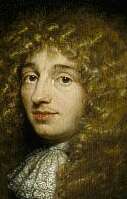 |
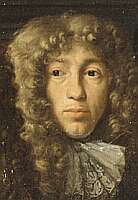 |
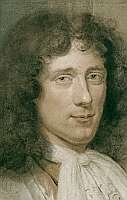 |
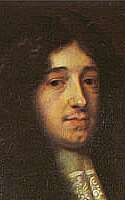 |
| 1671 | 167? | 1686 | 1688 |
I first compared the Testelin portrait with the Netscher painting. Both faces show the raised eyebrows, heavy, slightly drooping eyelids, eyes squinting looking a bit puffed, protruding lower lip and the slightly dented chin which in the later portraits of Huygens becomes more prominent. The Versailles portrait is more 'en face' than the Netscher portrait which complicates a comparison. Both paintings show a rather lean face with wide cheekbones, tapering toward the chin.
5. OC, volume 18, p 4.
6. Brown p. 150.
7. HARS II, p. 349-360; Maindron, p 4-5. Perrault, p. 43-47.
8. The name is mentioned in the RMN database and in Bayou, Th. (1998) La peinture à Versailles XVIIe Siècle: Buchet-Chastel/RMN, Paris, p. 112.
9. An erotic poem written for Ninon de Lenclos by C. Huygens sr. is by many later authors, starting with Voltaire, incorrectly ascribed to Chr. Huygens (See e.g. Condorcet, p. 133; Bertrand, p. 231; Barthalot; p. 25, who seems to follow Bertrand). In the biography of Descartes by Baillet (1692) a number of similar errors occur as Chr Huygens pointed out to P. Bayle. OC: volume 10: letter 2791.